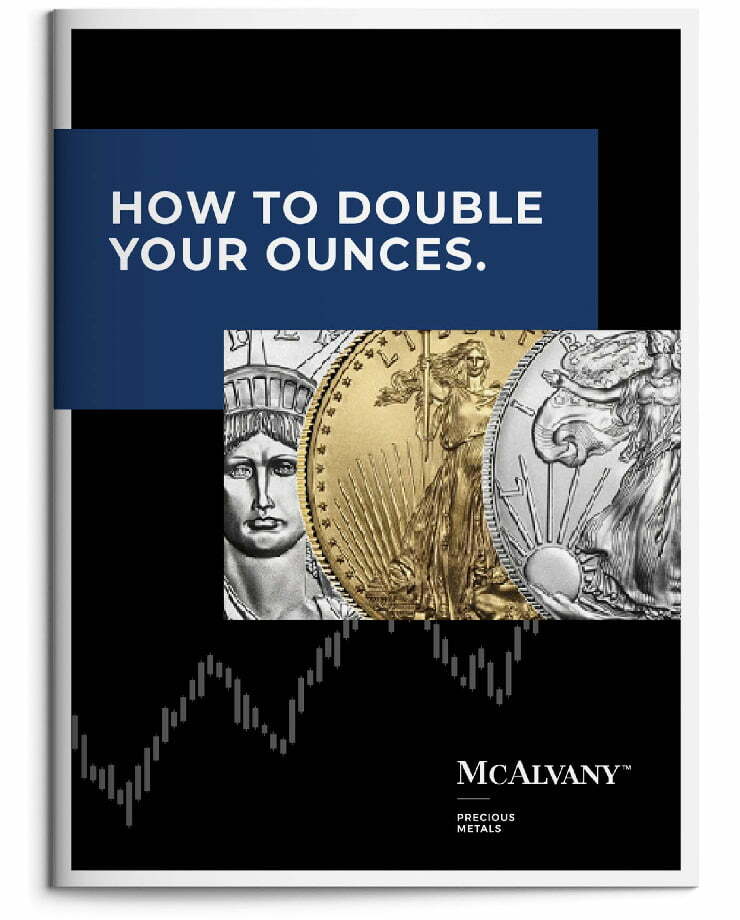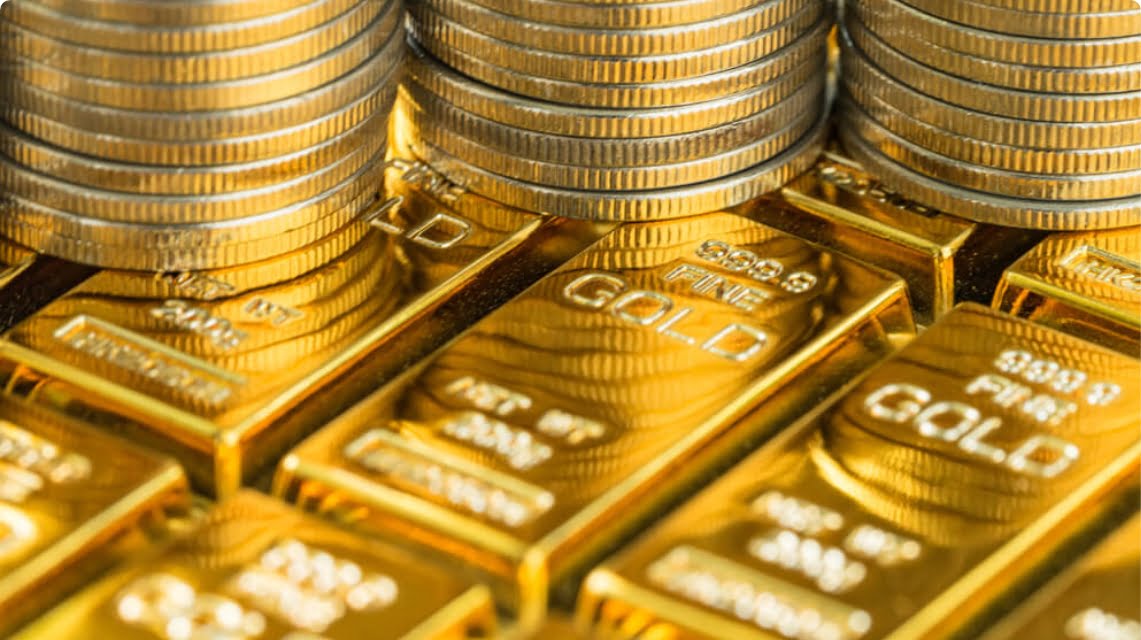Podcast: Play in new window
- Central Banks Now Have More In Gold Than In Euros
- 95% of Central Bankers See Their Gold Reserves Rising Over Next 12 Months
- Breakout In Silver & Mining Shares
“When I talk about the investor coming into competition for ounces with a price-insensitive buyer, what’s underappreciated about gold, truly underappreciated, is the supply inelasticity there. You can’t just run an extra shift to have more ounces available, keep the mine open through the weekend and create more ounces. That is key to the way price behaves. That inelasticity is something that I think is going to be on display in dramatic form in the years ahead.” —David McAlvany
* * *
Kevin: Welcome to the McAlvany Weekly Commentary. I’m Kevin Orrick along with David McAlvany.
Well, what a difference a day makes. I should say a week, but from one week to the next, Dave, B-2 bombers and bunker busters can make a very big impact.
David: Never a dull moment. As we discussed last week, B-2s would be involved to truly reduce, if not eliminate, the nuclear threat. Check. Done. We also made the case last week that Israel is not interested in peace with this Iranian regime, but certainly is interested in peace with the Iranian people, past aside. Trump is seeking, as we suggested, credit for bringing peace. You can see it moment by moment, deeply perturbed by noncompliance with the ceasefire, and his peace is indeed fragile. One Iranian official told Reuters, “We are rational enough to start a diplomatic process after punishing the aggressor.” I think the next headline is what people remain on tenterhooks over: “Tit-for-tat will remain the reality as long as there’s itchy trigger fingers.”
Kevin: Yeah. Iran’s retaliatory strike was telegraphed to Israel, telegraphed to the United States. We had our guys, fortunately, ahead of time in bomb shelters. But when you’ve got a regime that basically says, “We do not accept that Israel is a viable country going forward,” and if they continue with that, I have no idea how you get a long-term peace agreement, Dave.
David: Yeah. Well, you get the chief advisor to the IRGC saying that we need to slit the throat of Netanyahu, cut off Trump’s hand, and eliminate Israel from the face of the earth. That’s two days ago.
Kevin: Yeah. And we’re talking about peace agreement.
David: Right.
Kevin: Right.
David: Peace is indeed fragile. Ceasefires are not the same thing as peace agreements. Peace agreements are not the same thing as treaties. Even treaties are not the same as voluntary, enduring, cooperative, mutually beneficial relationships. Trump has made our friends reconsider those last words, and I think he’s pretty good at winning and deals. I don’t know that he’s very good at enduring relationships, and so whether it’s this relationship in the Middle East or our trade relationships in terms of trade which are less and less favorable, meaning we have less and less carrots, probably not a surprise that Trump needs more and more sticks as trade relationships remain strained. I think it’s worth considering the best signal of global economic realignment.
Kevin: Well, and those strikes were amazingly impressive, Dave. I was talking to a friend of mine a couple of days ago, and he’s very well-connected to military tactical decisions and weaponry, as well as he has a pretty good understanding of long-term strategy. He said, “We can celebrate and appreciate short-term tactical victories, but we should not mistake that with long-term strategic goals.” And so, Dave, when we talk about long-term, there seems to be various reasons for owning reserves, like these central banks. They own reserves to do transactions. Obviously, the US dollar is a transactional item, but they also own for security, a way of stepping outside of maybe the vulnerability of the US dollar. And gold has played that role over the last couple of years.
David: Gold has now exceeded the euro in terms of a quantity held by central banks as a reserve asset. Dollars are still the number one. Gold at 20% exceeds the euro at 16%. As we frequently highlighted, the trend in gold has in recent years been well-supported by central bank reserve asset managers increasing their purchases. The three-year streak has been consistent at over a thousand tons each year, which accounts for between 28 and 31% of annual mine production. Again, we’re talking about the best signal of global economic realignment. That is gold. That accumulation rate doubled, tripled the normal buying over the past 15 years. Their appetite is strong, and it’s spreading across the emerging market central banks, who are less—far less—allocated to gold than your developed world countries.
Kevin: You were talking about sticks and carrots with Trump. If you think about it, the sticks that we can employ and the carrots that we can employ have to do with our monopoly on the movement of money, and especially US dollars, access to that. Next week’s Commentary, Dave, we’re going to have Ed Fishman on, Eddie Fishman, who wrote the book Chokepoints. If you control the flow of money from one point to the next, whether it’s US dollars or the means of getting it transferred, then you really do control the world.
David: His subtitle tells you where the book is going, American Power in the Age of Economic Warfare. In next week’s Commentary podcast, we’ll talk with Edward Fishman, discussing his book Chokepoints. What he writes about is the invisible chokepoints that the Treasury Department, the Commerce Department, and State Department have crafted to guide diplomacy and reach strategic foreign policy objectives.
Kevin: Okay. So it’s a little bit like when you said an invisible chokepoint. Let’s talk about physical chokepoints like the Bosphorus and like Hormuz. The Strait of Hormuz right now is in the news because that can be choked off.
David: This week, we have heard a lot about the Strait of Hormuz. That is a physical and geographic chokepoint which, under worrying circumstances, could halt 20% of global oil supply from reaching end markets. Fishman served in the State Department, at the Pentagon, and also at Treasury. His narrative history of our economic warfare engagements includes the way that we’ve handled our relationship with Iran, past up to the present. Russia, China, also big segments in the book, and are critical for any informed investor to have considered as you’re looking at allocations, as you’re looking at the world as it is, and as it is becoming. He also contextualizes the move to gold by global reserve managers.
When you see that economic warfare is the state we exist in, and consider the hardening of liquid assets from the attack of foreign interests, that is what central banks are doing in response to a two-decade tightening of various chokepoints. I think you’ll agree, the trend of gold acquisition is in its infancy, when you survey the facts as he does. Guarding the agency of the state is not unlike the individual, the choice an individual makes when buying gold, at least theoretically. We may have different risks, but hardening a liquid asset base from the vagaries of the stock market, from inflation targeting by the Fed or various central banks, or more existential threats, it’s important.
Kevin: Well, and why do central banks buy gold in the first place? They’re not really price sensitive, are they?
David: No. This year’s survey of central banks conducted by the World Gold Council had more voluntary respondents than any other, ever, which on its own is a positive sign. Of the 73 central banks that participated, 95% see reserves of gold increasing over the next 12 months. That is, they anticipate their colleagues to be buying. None of them—surveyed—intended to reduce their ounces, and 43% were making a commitment or anticipated adding, themselves. 73% of the respondents plan to moderately or significantly diminish their dollar reserve holdings over the next five years. Again, this is an enduring trend as they increase their exposure to the euro, the RMB—which I thought was very interesting—and of course gold.
Kevin: Going back to the question. Central banker, if you asked him what is it that actually influences his decision on what he holds his reserves in, what did they say?
David: When asked which topics were relevant to their reserve management decisions, 93% indicated interest rate levels. What fascinates me about that is that interest rate differentials favor a migration into US Treasuries. We currently have higher interest rates than most of the world. Of course, Trump is not too happy about that, and he’s been pounding Powell over not lowering rates. But as it stands, we have about 100 to 175 basis point—1 to 1-3/4 percent—differential. And yet respondents are talking about walking away from US assets. Even with more attractive yields on offer.
Across Europe, you’ve got bond yields that are notably lower than in the US, with the Swiss National Bank making the decision last week to return to 0% interest rates. And yet, for a variety of reasons, they prefer lower yields to those on offer in the US Treasury market. It reminds me of what Gillian [Tett] had to say in a Financial Times article a few weeks ago. We’re moving to a backdrop where politics is driving economics. More than anything, you could argue that the central banks are making a political decision. It’s not just about the math anymore.
Kevin: And they don’t really want to admit that. They’d rather say, well, it’s interest rates that are driving us, but that’s a contradiction because they’re actually buying gold. So what are the relevant factors in the decision to buy gold?
David: 85% of respondents indicated that gold’s performance during times of crisis is highly or somewhat relevant to their organization. 81% of respondents also indicated that gold’s attribute as a portfolio diversifier was a relevant factor. 80% highlighted also its role as a store of value.
Kevin: Well, and we can go back to the 1970s when your dad first started the firm and started working with clients with gold as a strategic reserve asset. Remember when Russia invaded Afghanistan in the late ’70s, what happened to gold? It doubled. You’d want to be in gold at that time.
David: And you actually go back to the standard definition of money, stored value, means of exchange. These are things that, wait a minute, are they making an allocation to a commodity or are they making a currency preference choice? And I think that’s a way that investors will continue to shift in their thinking towards seeing gold as the best expression of a liquid asset base. And again, a way to harden your liquidity position.
Kevin: These aren’t short-term decisions either, are they? I mean, they’re looking long-term when they’re buying gold.
David: I think their response has reinforced gold’s appeal as a strategic reserve asset. And all these motivations remain relevant, as you say, over longer time frames, which is important to keep in mind. The buying is with the intent of holding to maintain a crisis hedge for diversification and as a store of value—not today, and all of a sudden we don’t need that tomorrow, but these are sticky buyers, price insensitive and sticky buyers. So very few geopolitical analysts, let alone reserve managers, anticipated the past week’s start of a war in the Middle East.
And of course this is outside of Gaza, but it serves as a reminder to the respondents in that survey, perhaps a few bankers in the disinterested gold category—now they’re considering buying it—that gold is an important allocation, both past, present, and future. When investors turn to the precious metals in earnest, I think what they’ll quickly discover is a competition for ounces with that price insensitive buyer.
Kevin: Well, and we remember back in 2008, talk about that competition for ounces. We were so locked out of the gold market, and people were so locked out of the gold market while everybody was moving in during the global financial crisis. Dave, you went to Switzerland. I went with you, and you met with means of actually getting gold at a quicker pace because of that competition for ounces. You remember that trip?
David: Well, that’s right, directly to the refiners to make sure that we had supply. Again, when I talk about the investor coming into competition for ounces with a price insensitive buyer, what’s underappreciated about gold, truly underappreciated, is the supply inelasticity there. You can’t just run an extra shift and have more ounces available, keep the mine open through the weekend and create more ounces. That is key to the way price behaves. That inelasticity is something that I think is going to be on display in dramatic form in the years ahead.
Kevin: So let’s contrast that because when we do bank ratings, Dave, for our clients, we talk about the hot money ratio. Hot money is money that really has no loyalty and it can move out of a bank very quickly. It’s there literally for the interest rates, and if it finds an interest rate that’s higher somewhere else, it’ll just move.
Hot money is something you can’t count on. Now, you said something about sticky buyers. Gold is— Especially the people who’ve been buying the last few years, which is the central banks, not only are they sticky buyers, but that’s the opposite of hot money.
David: The hedge fund crowd would certainly be an example of hot money in the gold market. Buy today, sell tomorrow, pocket the difference, if you don’t take your gains, you’re not going to get paid your two and 20, the 20% bonus on performance. So out of a long list of relevant factors, just by contrast to the hedge funds, going back to the central bank survey, the relevant factors considered in planning to own gold, the number one behind being a historically held asset, which is really characteristic of your developed economies. And I mentioned earlier, it’s the developing economies which are the big buyers here. Number one reason considered in planning to own gold: no default risk.
Kevin: True. Nobody’s ever gone broke in gold, have they?
David: Yeah, I mean, it’s a tier-one asset, categorized as such by the Bank of International Settlements. You can hold it as a reserve and it is not something that is anyone else’s liability. You follow the no default risk by performance during a crisis. And the two categories— Those are at the top of the list. The bottom of the list, categories of least concern, both at 7% of respondents: sanctions—they’re not really buying gold because of sanctions—and change in the international monetary system. Again, not top of the list at present.
So gold’s relevance as an important geopolitical diversifier ranked 78% amongst emerging market central banks. And I think that point’s going to become even more clear in the conversation with Edward Fishman next week. Only 46% in advanced economies were concerned about having a geopolitical diversifier. And again, that may be because they already own a lot of gold. If you think about the total quantity of gold held, it’s France, it’s Italy, it’s Germany, it’s the United States. And they’ve held it for decades upon decades. So it’s the emerging markets that are allocating most aggressively in recent years, playing catch up—and obviously, I think, paying close attention to geopolitics.
Kevin: So would it be safety that gold is providing right now? Over everything else, safety?
David: Yeah, for sure. Again, it’s just a way of gaining control over an asset. And we’ve noted repeatedly, 2022 was the mark in time. If you’re looking at timeline, that’s when central bank interest was picking up dramatically, and that is when the U.S. Treasury took over roughly half of Russian reserves.
Kevin: We weaponized the dollar.
David: Weaponized the dollar to about $300 billion, and we basically did something that was unthinkable even to Lavrov and the folks in Russia that we would sanction the central bank and directly control their reserve assets. So why are central banks looking at a reserve asset that is non-controllable? This is not rocket science.
Kevin: So the survey concluded with: it’s safety, liquidity, and return, basically, right?
David: Yeah, eighth’s annual survey, a quote from the piece. “As the world becomes increasingly volatile and unpredictable, gold’s safety, liquidity, and return characteristics—the three key investment objectives for central banks—have risen in importance.”
Kevin: The thing that’s made this particular bull market interesting, Dave, working with the general public, is that the general public doesn’t know this yet. It’s like there’s two rooms. The room of the central bankers who are going, you know what? We need safety, liquidity, and return. We are stepping aggressively—especially from 2022 on—we’re stepping aggressively into gold and away from dollar dependence.
And yet you see the buying public coming in when you see the mining stocks going up and when you see them buying ETFs because central banks don’t buy ETFs, but the public does. Now, are we seeing an increase? I know we’re starting to see a move in mining stocks like we hadn’t seen before.
David: Yeah, I spoke to an ETF operator last week, and they talked about how they’d seen an increase of 28 tons in demand into their product in 2022 that was then sold back in ’23 and ’24. And only eight of the 28 has come back into the market. So from the World Gold Council statistics, investor demand for gold via ETFs is on the increase. But 349 tons, year to date, 214 of those attributable to the first quarter, it’s beginning to pick up again. By the end of March, U.S. ETF buying was up 8%, and now, year to date, it’s up 11%.
Interestingly, to contrast U.S. buying, Asian demand increased by 15.9 by the end of March, again, end of Q1, and is now up 46% year to date. A little bit more of an appetite amongst Asian investors.
Kevin: So a lot of times the general public, they’re looking for returns. We talked about the motivation with central banks, and they’re not buying gold for what the return is offered. They’re buying it for reserve safety. So the return on gold, you would think, compared to other investments would be pulling the public in right now.
David: Yeah, in terms of returns, with this year’s move higher, gold now has a 10-year compound annual growth rate of 11 and a quarter percent. If you look at its 20-year CAGR, again, compound annual growth rate, it’s at 10.99, which surpasses U.S. equities, which are at 10.53. Again, this has been an incredible bull market in metals. It continues, and we don’t see the energy dissipating. In fact, with the Western investor beginning to reallocate and reposition, looking at the performance differentials, there’s a lot still ahead.
Kevin: So from a Western investor’s point of view, who wants to be ahead of the curve, this has been sort of a sleeper bull market up to this point. Most people have missed it.
But let’s go back to the World Gold Council, because one of the things that I would wonder decades ago when I first came to work here, I had heard the gold tonnage reserve assets for central banks was like 38,000 tons. And then it dropped. Most of the years that— You know, I started in 1987 and the central banks were net sellers of gold really until, what was it? About 2008, 2009. The Global Financial Crisis. Then they started buying.
David: They were super aggressive in the late nineties, and in the early aughts, also very aggressive. Then the Global Financial Crisis occurs. And maybe that was the inflection point, right? But they became net buyers after that. And for the first time in many decades, we come back to the no default risk motivation. Who’s concerned about default for the time period up to the Global Financial Crisis? It’s not something that you thought about unless you wore a tinfoil hat or, I don’t know, a Chicken Little. You didn’t really consider default, and the percentages were so low statistically, it wasn’t a risk that you had to factor in.
From that point forward, you see a marked change in central bank behavior. It has only accelerated since 2016, and again since 2022. What the World Gold Council Survey did not capture was the aggregate of ounces that central banks have today. 36,000 tons held by all central banks. It is close to the old highs of 38,000 tons. But still, if you look at it compared to economic growth, to liability expansion, to financial asset growth, it’s a fraction. It’s a fraction of the reserves, again, relative to how balance sheets have grown and things of that nature. 38,000, that’s the numbers from 1965.
Kevin: And Dave, these are official numbers. Being in the gold world now, especially this last decade, we know that China’s been buying a lot more gold in tonnage than what they actually officially announce.
David: And the World Gold Council does not venture a guess on that. You’ve got Jan Nieuwenhuijs who writes The Gold Observer for Substack, and he notes that the PBOC’s clandestine buying takes the total to 39,547 tons. That’s his estimate. Jan confirms that in 2025, PBOC buying has been in the neighborhood of 144 tons. That’s just in Q1, 48 tons a month versus the 51 tons he accounts for each month, purchases from the PBOC in 2024. So reported purchases, if you’re talking about the official—what the PBOC says they’re buying—versus what would be clandestine purchases, reported purchases are only about nine percent of the estimated actual additions.
Kevin: And the People’s Bank of China, they’re also not speculating on gold’s price. You know, I’ve got a book at home called Know Your Why. In other words, it’s just like, if you do something, know exactly why you’re doing it.
David: Well, I would say keep the why question in mind as we move to the Fishman interview next week.
Kevin: Okay.
David: Why shift reserves to gold? Fishman gives you a geoeconomic perspective into a changing world order, and a struggle for economic dominance fast becoming a zero-sum game. Gold is a tell. Gold is also a tool for administering finances and paying bills when assets have been restricted. Fishman, I think in his book, seals the case that we have been in an economic war since 2001. He certainly suggests that economic warfare goes back to ancient Greece, Sparta. This is not new, but we certainly have new tools, and these are the invisible tools as opposed to the most visible geographic choke points, which historians would certainly know all about.
What we have refined from then to now is the weaponry, with our global trade partners beginning to see more clearly as time wears on that our actions are not so benevolent, and are more and more inwardly focused. It’s not that we are anti-globalization. I think the US remains pro-globalization, as long as there is a vortex funneling the benefits back to us first and foremost. In that sense, all economic roads, from a US perspective, to Rome.
Kevin: Yeah. All economic roads lead through the dollar to Rome, right? As long as you’re using the dollar, we’re all for globalization. As long as America benefits. And I get that, but you know, how fickle. How fickle are we, Dave? You often do interviews on daily market moves, and it’s amazing to me how short-term the thinking is. If the price is up one day, it’s a great investment. If it’s down another day, it’s a terrible investment. You did an interview just a few minutes ago for a network, and I think that was sort of the stance, wasn’t it? It’s just like, “What’s happening today?”
David: Yeah. I think, broadly speaking, social media tools have retrained our brains to think in nanoseconds, and to not be able to think over longer periods of time. We get a tweet and we’re interested in the next tweet, and it might be a different opinion two seconds later, and we’re drawn to a news cycle which is nano in nature.
Yeah, I did an interview earlier today. We talked about oil and gold. Then the conversation quickly turned to crypto. It was a weird conversation, because it went like this. “Gold is down. This is terrible. Why is it performing so poorly?” And I had to remind the gal that it was up over 26% year to date. 26% year to date, and the performance differentials were telling us something important, certainly relative to equities.
And then she said, “Well, oil is sliding. Basically the slide will never end. Everyone is bearish.” We talked about that for a bit. And finally, bitcoin. “Bitcoin’s up today. What do you think about the broad adoption by institutions and corporations?” I’m thinking, “Well, funny you should ask. I have an opinion on crypto.”
Kevin: So let’s talk about long-term cycles. Because when you get toward the end of, let’s call it the greed cycle, or the risk-on cycle, people no longer see the danger, they just see the return. Are we near that top? I mean, is that the kind of thing that we’re experiencing with those types of interviews?
David: Yeah. You basically see return extrapolation instead of looking at market fundamentals. And the market can move beyond fundamentals. It often does that. But you have to acknowledge that there’s greater and greater risks embedded in a market where fundamentals are no longer paid attention to. Again, that sort of return extrapolation, “What happened yesterday we’re going to have for tomorrow.” And Wall Street is very keen on covering their backsides, reminding you at every turn, past performance is not a predictor of future results. And yet what do they talk about? Past performance being a predictor of future results.
Kevin: Right.
David: It really is like a CYA, make sure the legal department doesn’t get after you. Two themes are suggestive of late-cycle adoption and imminent musical chairs moment. I think one is in crypto and the other’s in private credit.
Kevin: Okay. So going back to the knowing your why, oftentimes people will say, “Hey, Harry, should I buy cryptocurrency?” And I’ll say, “Why?”
David: Because it’s going up.
Kevin: Because it’s going up. And so they seek— Well, let’s put it this way. We all seek for validation of something that’s new. And right now the news is basically saying that institutions are moving into bitcoin. What are your thoughts on that?
David: And by the way, because it’s going up is not a bad reason. It’s just not the best reason.
Kevin: Right.
David: And if you’re comparing that to other assets that you can have really solid reasons to own, well, I think you’re talking about managing risk at that point, and not just looking for reward. The case in crypto is US companies tying their treasury or cash balances to bitcoin. Jim Grant describes it as the bitcoin Treasury movement. This is really interesting, where publicly traded companies, lured by the possibility of trading at higher multiples relative to peers, are using cash, are issuing debt, are issuing preferred stock, and padding their balance sheets with bitcoin exposure. A year ago, the number of bitcoins held by public companies was 312,200 bitcoins. And as of June 17th, the number reached 832,162. About four percent of all the coins in circulation.
Kevin: Isn’t that amazing? I mean, I’m just sitting here thinking, I remember being a toy store manager during the Cabbage Patch craze. You know those Cabbage Patch dolls? And it’s almost as if Coleco, the maker of those dolls, is now saying, “Oh no, we don’t make dolls anymore, we invest in bitcoin. And our shares are going up. We don’t need to sell dolls. We’ll just buy bitcoin.”
David: You know, or said differently, what if a non-toy store was basically saying, “Look at the craze in Cabbage Patch dolls.”
Kevin: Yeah.
David: “Why don’t we have those on our balance sheet?” I mean, it has nothing to do with drilling for oil or selling Pepsi.
Kevin: Yeah, Exxon. “Stop. Let’s don’t drill for oil anymore. Let’s just—
David: “I think we should have a position— We definitely should have a part of our cash position— Why don’t we issue debt to buy Cabbage Patch dolls? Because look, what’s happening? Price is going up.”
“What you need to be aware of is the adoption cycle. I mean, you’ve got Wall Street paying attention, you’ve got family offices paying attention. Everybody’s paying attention, and I think you just need a few Cabbage Patch dolls on your balance sheet. Let’s borrow to do that. I mean, look. With this kind of popularity, you understand this is a very liquid asset. I mean, they’re so popular, you want to sell a billion Cabbage Patch dolls, you can do it.”
Kevin: Okay, so let me just tell you a quick story on that. So we could not get enough as a toy store back in, I think it was 1983. We could not get enough Cabbage Patch dolls. Purposely. Coleco made sure that there was a scarcity. The next year, we could not give them away. It was done. It was done. Laser tag was the next big craze, but Cabbage Patch dolls— So, I’m wondering, let’s go back to late cycle dynamics. In a bull market, when everything’s going up, everything was Cabbage Patch dolls for a year or for a Christmas, let’s put it that way, and the next year, it wasn’t.
David: Yeah. What works in a bull market? Again, price action. Pay attention to it. Price is going up. There’s nothing that says the price can’t go higher. What’s to prevent bitcoin from going to 150,000, 200,000, 300,000, but what works in a bull market tends to have an opposite and at least equal reaction in a bear market.
Kevin: So, that’s Sir Isaac Newton’s quiet investment advice that whatever, at least equal reaction in a bear market, right?
David: Yeah. Quarterly reporting of financials may be the undoing of the strategy. You get the financial accounting standards board, accounting standards require that crypto assets, this is as of December 15th, 2024, have to be recorded at fair value. Mark-to-market is one way of establishing fair value. Maybe they won’t be forced to mark-to-market. Perhaps there will be an allowance for models. Bitcoin may be priced 20% below what we’re carrying it on the books, but there’s a reason for us to do so. Regardless, those changes in value are recognized as an addition to or subtraction from net income. So, load the boat with bitcoin, rebrand your company, and speculate with your retained earnings. Not a problem.
Kevin: Do you remember when the phrase “mark to make believe”— We were bantering that about in the Commentary. I think in 2008.
David: 2008.
Kevin: Yeah. Mark to make believe. Is this genius or is this stupidity?
David: It is genius. It’s a genius way to leverage growth without improving sales margins or any other part of your operation. If bitcoin doubles in value, the share prices of these companies soar irrespective of the underlying businesses. And the other side of that is if bitcoin tanks, companies better be betting on a massive uptick in sales, margin growth, and whatnot in their core businesses. The problem with the play, as I see it, is it’s too procyclical a choice to pass as responsible by any fiduciary.
Kevin: So, let me ask you, are we going to continue to buy and sell gold, Dave, or are we going to play the same game and just go ahead and take our assets and put it into bitcoin?
David: Bitcoin, of course.
Kevin: Yeah. I just wondered. Okay, so let’s distinguish the why. Okay. Because we heard for a long time that crypto was very similar to gold, and gold is considered a risk-off investment. So, when something happens geopolitically or when the markets come down, a lot of times people move into gold. That’s a risk-off investment. Risk-on investments are like your tech stocks and crypto. Crypto’s behaved in a way that we know it’s a risk-on investment.
David: Yeah. Whether it’s the past six months, six years, look at the first quarter’s performance of the equity markets and crypto, and then with the revival within equities and the easing of tensions in terms of trade in the second, third week of April, guess what happens? Markets are alive. Bitcoin’s alive.
Crypto is an expression of risk on. It works very well in a period of business expansion, very well in a period of speculative hype, but the asset class suffers in periods of risk off, and that’s why being procyclical—again, back to it being an irresponsible choice for any fiduciary—being procyclical, I think, it’s a bad idea. When you need liquidity most—we’re talking about a future hypothetical risk-off environment—the assets you chose are less liquid and subject to significant loss. Strategy, which is the new name of the old company MicroStrategy. It was a profitless software company. They decided to go all in on bitcoin, CEO Michael Saylor, so confident in his bet on bitcoin, they’ve issued $2 billion in preferred stock, paying 10%, another $1 billion in convertible preferred paying 8%.
Kevin: Wow. Those are nice returns and I guess they’re going to come, right? That’s mark to make believe.
David: Never mind that there isn’t enough cash flow in the business for operations and debt service.
Kevin: But they are going to pay 10%.
David: Well, he’s an uber-bull while he can sell from his profits and make payments, but again, it ties to “nothing can go wrong.” Sounds like the Mississippi scheme. I think John Law and Michael Saylor have more than a few things in common. Perhaps IQ is among them. No doubt, he’s bright. Well, maybe he’s bright, but hubris often is the shadow, following IQ around wherever it goes.
Kevin: Yeah. Well, okay, so there’s another element—we’ve talked about investments that offer mark to make believe—private equity and private credit. You’ve talked about that in the past as being something that is late cycle. It could be a disaster.
David: Yeah. Private cycle is the second late cycle expression. By late cycle, I mean this market up cycle, not just short-term cyclical, but a secular cycle. In the short-term stretch of growth, we could certainly see the old highs in the equity indices, but private credit, as we’ve previously discussed, is where private equity has gone to die. 29,000 unsold companies in private equity, a backlog of over $3 trillion in companies waiting to either be IPO-ed or resold. Private credit has filled the gap.
And so, what’s interesting, insurance companies—and this according to Evan Lorenz, also at Grant’s—insurance companies have piled one-third of their cash and invested assets into private credit as of year-end 2024, with the intention of adding even more. That’s according to a Moody’s survey of industry CFOs. Never mind the increase in loan defaults within private credit. Never mind the tripling from 2% to 6% of credit funds that couldn’t make cash payments and had to resort to payment in kind. That’s in the first quarter of this year. Essentially, what they’re doing is they’re adding the debt payment, which they couldn’t make, onto the principal balance.
Kevin: Well, you’re talking insurance companies, which, talk about long-term assets. These are the guys who cannot take short-term risk. They’re insurance companies, Dave.
David: And again, what feels so late cycle is having piled one third of their cash and invested assets into private credit, it’s like a sure thing, and yet nothing in life is a sure thing.
Kevin: But you said 29,000 unsold companies. That goes back to the Cabbage Patch thing. There was inventory everywhere the next year, couldn’t get rid of them.
David: Lorenz also highlights the danger embedded in continuation funds, where a private equity firm can’t sell its assets, so it creates a new fund and dumps the unsellable assets into that fund, allowing for the first round of investors to exit.
Kevin: That sounds like what happened back in 2008.
David: Well, who’s the genius in that transaction?
Kevin: Wow.
David: Six months ago, I sat in an investment committee meeting for one of the state universities, and the idea of continuation funds was circulated. Great idea. Everybody’s super excited. Lucky us to participate in a portfolio of companies that previously was inaccessible. I just kept on thinking, beauty is in the eye of the beholder.
Kevin: Do you feel outnumbered on that board? What are you there for, Dave? They can’t possibly agree with you because you’re a little bit— What do you like? I guess that would be the question. What do you like? Because these guys are like, “Oh, you’re just such a Debbie Downer. Everything that we want to buy, you say, ‘Watch it. It’s not going to be good for the university.'”
David: Sometimes, I feel like the 10th man, but I’ve also been in a position where we were in a market downturn and we had 10% of the funds allocated to gold, and we were ready to reallocate to other things, and at that point, I’m the contrarian again, saying, “We should be putting money to work.” And they’re like, “No, no, no.” Losses, we’re hemorrhaging. We’ve got to reduce risk. It’s time to sell. Of course, buy high, sell low. It’s the American way of losing money. How do you make a million dollars in the stock market? Start with two—at least if you’re following that same pattern of buy high and sell low.
Kevin: So, the curmudgeon in the room, okay—
David: —is not always a curmudgeon.
Kevin: What do you like right now?
David: Better looking to me, the breakout on silver over $35.
Kevin: Yeah.
David: Better looking to me—again, beauty is in the eye of the beholder. Better looking to me: mining shares. Better looking to me: a position in gold ounces which provides a source of liquidity for a world that is at war, and if not a kinetic war entirely, very much a financial and economic war. You don’t want to miss next week’s conversation with Edward Fishman to explore how extensive that war and what is at stake.
* * *
You’ve been listening to the McAlvany Weekly Commentary. I’m Kevin Orrick, along with David McAlvany. You can find us at McAlvany.com and you can call us at (800) 525-9556.
This has been the McAlvany Weekly Commentary. The views expressed should not be considered to be a solicitation or a recommendation for your investment portfolio. You should consult a professional financial advisor to assess your suitability for risk and investment. Join us again next week for a new edition of the McAlvany Weekly Commentary.
















